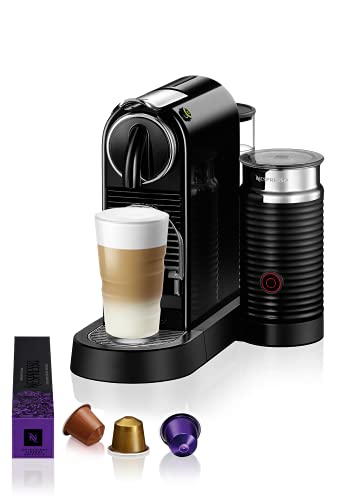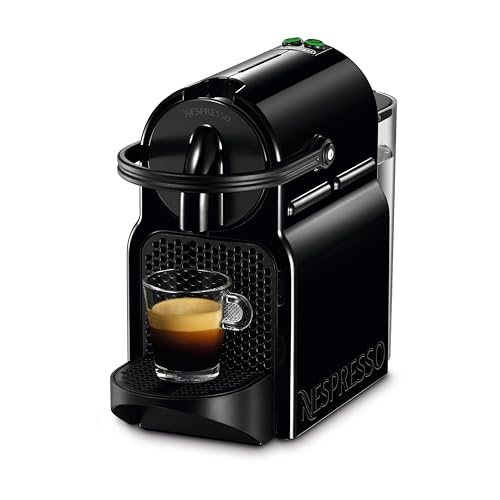고객게시판
10 Meetups About Nespresso Coffeee Machine You Should Attend
페이지 정보
Tara
2024-10-02
-
2 회
-
0 건
본문
 Nespresso Coffee - The Essenza Mini
Nespresso Coffee - The Essenza Mini The Essenza Mini is compact, affordable and very easy to use. It doesn't have a removable drip tray or water tank to keep it small. But, it makes great espresso and lungo.
The Essenza Mini is compact, affordable and very easy to use. It doesn't have a removable drip tray or water tank to keep it small. But, it makes great espresso and lungo.It works by piercing the capsules and then pumping water under pressure. This creates different sizes of espresso and coffee drinks, including 1.35-ounce espressos, 2.7-ounces double espressos, 5-ounces gran lungos or 14-ounces altos. It can also be used with a free-standing milk frother.
Capsules
The Nespresso system lets you make coffee at the touch of a button. You can select one-serving cups or a larger one and each capsule has the right amount of coffee beans to give you the strength you want. You can also add milk powder to make a cappuccino, latte macchiato, or other drinks. The capsules can be reused or disposed of without guilt as they are made from biodegradable material.
The pods are made of aluminium and can withstand the high pressure of the machine. The hermetically sealed pods are tamper-proof, and the coffee grounds inside remain fresh and protected from moisture and oxygen. In addition, the aluminium is 100% recyclable, which aligns with Nestle's environmental goals.
However the system isn't without its drawbacks. The machines are expensive both to purchase and operate. The capsules are also expensive to purchase and need to be replaced frequently. The machines are also able to only be used with capsules that are branded nespresso coffe machine. This has led to a variety of lawsuits between Nestle and third-party companies, that use the same extraction method and ingredients as Nespresso.
Despite these disadvantages, the Nespresso system offers many advantages which include premium coffee and sustainability for the environment. It's a great alternative to the traditional tea and coffee bags, and it has a much higher extraction rate than other single-serve systems. A single capsule can produce up to 14 ounces of espresso coffee machine nespresso.
The original capsule was developed in 1976 and was patented in 1978. Its most important features are an cone of aluminum foil with a flat-topped top, an elongated recess that the machine injects hot water and a small opening in the base that is punctured from above and below. The machine spins the capsule at 7700 rpm to infuse the coffee with water, resulting in the thicker crema.
Water
If you are using a nespresso coffee pod machines machine, it's essential to use high-quality water. This ensures consistent quality, and is also crucial for the flavor and texture. You should make sure to use "filtered" water or "spring water," and avoid tap water or distillate water.
In our lab tests we discovered that machines that use softened water make more satisfying espressos and lungos than those that use hard water. Hard water can cause calcium deposits and other issues that impact the taste of your coffee.
Each time you drink a cup of coffee, the Nespresso machine is able to take in and pumps out hot water at high pressure. This process is known as extraction. The temperature, duration and pressure of the process of extraction determines the flavor and intensity.
The Original machines pierce and then pump the capsule, while the Vertuo models work by reading barcodes that are printed on the capsules to determine how much water is needed for a particular type of espresso. The Vertuo models can brew six different drink sizes, including lungos and espressos, with or without a cap of foam.
All the machines that are part of the Nespresso range can offer 19 bars of pressure. Some of the more expensive models also brew cappuccinos and macchiatos with latte, and some even offer the option of making Iced Coffee.
The Inissia and U series machines have compact bodies, making them easy to fit into tight spaces. The Nespresso Pixie, which has an integrated frother, is a different compact option. It can be used in conjunction with Nespresso's app to access custom recipes and to reorder capsules. Nespresso is a great option for anyone looking to reduce their plastic footprint and also support the company's sustainability program.
Temperature
While Nespresso machines may be more complicated than your average coffee maker, they are built for speed and user-friendliness. Each capsule is prepared in a matter of seconds. They are also relatively efficient. Nespresso machines use less energy than traditional drip coffee makers to brew capsules.
Some models of Nespresso coffee machines come with a milk frother that can be used to make cappuccinos and lattes. Some of these models also have a separate capsule container that can hold up to 12 used capsules at a time making them easy to recycle.
The Nespresso brand is supported by several well-known kitchen appliance manufacturers, such as Krups DeLonghi, and Breville. The majority of the machines are manufactured by Eugster/Frismag which is a Swiss company that is one of the largest coffee-machine makers. This has led to criticism of the company's use patents and other similar strategies that printer manufacturers to establish vendor lock-in.
Pressure
To get the best espresso, you should keep an even pressure throughout the extraction. This is known as "pressure profiling." Pressure profiling is the process of changing the amount of pressure that is applied to the coffee grounds to ensure a perfect extraction and enhance the flavor. This technique can be achieved with various espresso machines, like Nespresso coffeemakers.
There are many different ways that espresso machines alter pressure during extraction. A balanced bypass regulates the water pressure at a fixed amount, typically 9 bar regardless of the inlet. This is a simple, effective method that ensures that all espresso groups have the same pressure throughout the extraction process.
A lever or control knob can be used to adjust pressure manually. This method is more difficult, but can provide more flexibility and control. Manual pressure regulation can produce inconsistent results. It requires a high degree of expertise and focus.
Some espresso machines utilize a dynamic pump to adjust the pressure according to the temperature of the coffee grounds as well as the type being employed. This type of system is more sophisticated, but can produce better results than other types.
Nespresso has a range of machines which can be used to make coffee, lungo drinks and some are also able to froth the milk. The Nespresso Inissia is a fantastic option for baristas at home, as it can make between seven and nine espressos at once and has a 33-ounce water tank. It is also equipped with buttons for different sizes of drinks and includes an ice tray that can hold up to nine pods that have been used. The Nespresso Vertuo Next was designed to be versatile. It comes with 11 different milk temperatures and eight different milk textures. It also comes with a large stainless steel milk frother wand, as well as a container that can hold up to 18 ounces of used capsules.
Cleaning
Every time you use a Nespresso it will leave behind mineral and limescale residues. These can get mixed in with your coffee and cause it to taste bad. To prevent this from happening, it is essential to clean regularly your Nespresso machine and all its parts. A thorough cleaning is required, which includes washing and descaling the removable parts, including the drip tray and capsule container. A daily rinse with fresh water can also aid in preventing mineral buildup and enhance flavor.
Utilizing a de-scaling product can help eliminate mineral deposits from your machine. You can find these products in a variety of coffee and appliance stores. Alternatively, you can try vinegar. This gentle cleaner won't harm your equipment, but it might take longer for the minerals to dissolve than a descaling solution.
If you choose to use vinegar, remove the coffee pods first before you empty the reservoir. Then, pour out the rest of the water from the tank, as well as any water filters built-in. Pour in the vinegar and run a brew cycle without coffee pods to allow it to flow through the machine. After that, rinse it with clean water and run a few more cycles to make sure there are no traces of vinegar left in the machine.
When you've got your machine cleaned, you can wipe down the exterior as well as its removable parts. Pay particular attention to corners and crevices where gunk could get caught. You can clean the parts that are removable with mild soap in your dishwasher, or by hand. Rinse them thoroughly. You should also examine the seals around the capsule and coffee outlet and replace them as necessary to maintain their elasticity and to prevent leaks.